译林版(2019)必修 第三册Unit 4 Scientists who changed the world:Grammar and usage课件(共25张PPT)
文档属性
| 名称 | 译林版(2019)必修 第三册Unit 4 Scientists who changed the world:Grammar and usage课件(共25张PPT) | 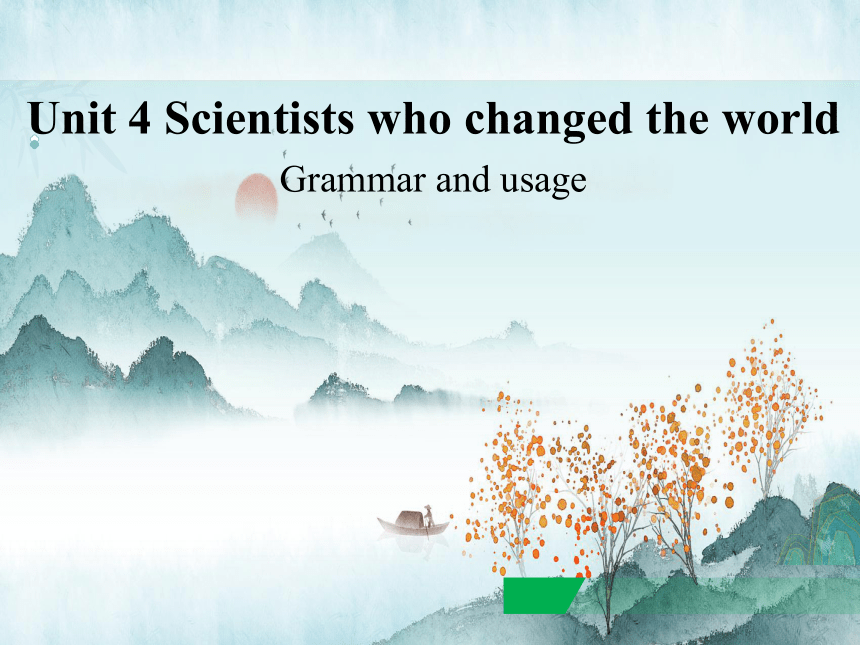 | |
| 格式 | pptx | ||
| 文件大小 | 5.6MB | ||
| 资源类型 | 教案 | ||
| 版本资源 | 牛津译林版(2019) | ||
| 科目 | 英语 | ||
| 更新时间 | 2025-01-13 11:57:30 | ||
图片预览

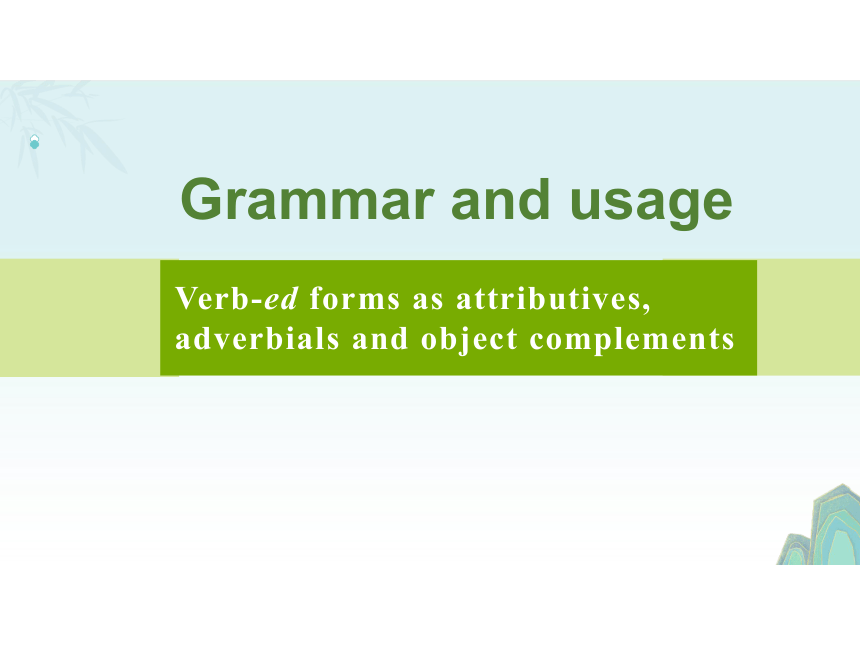
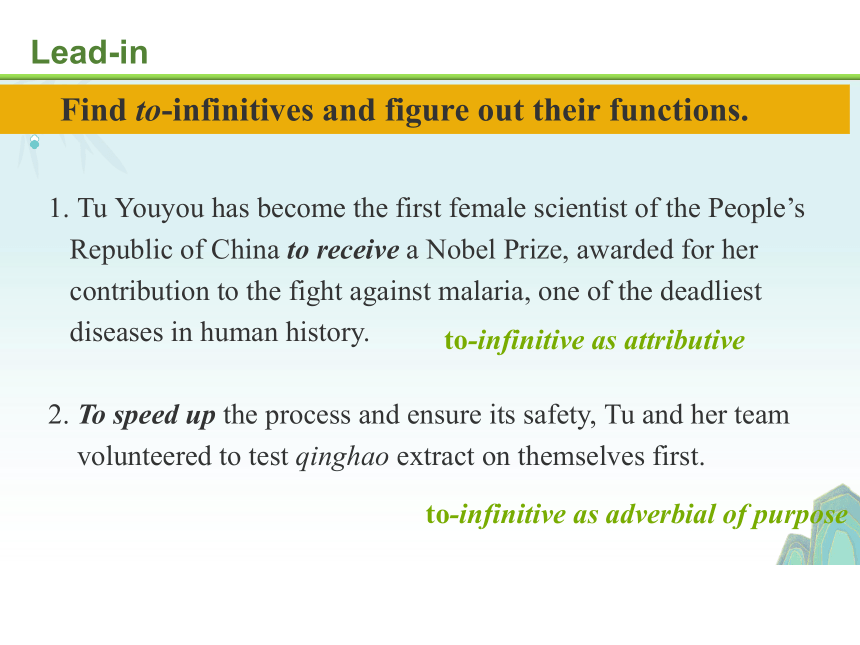
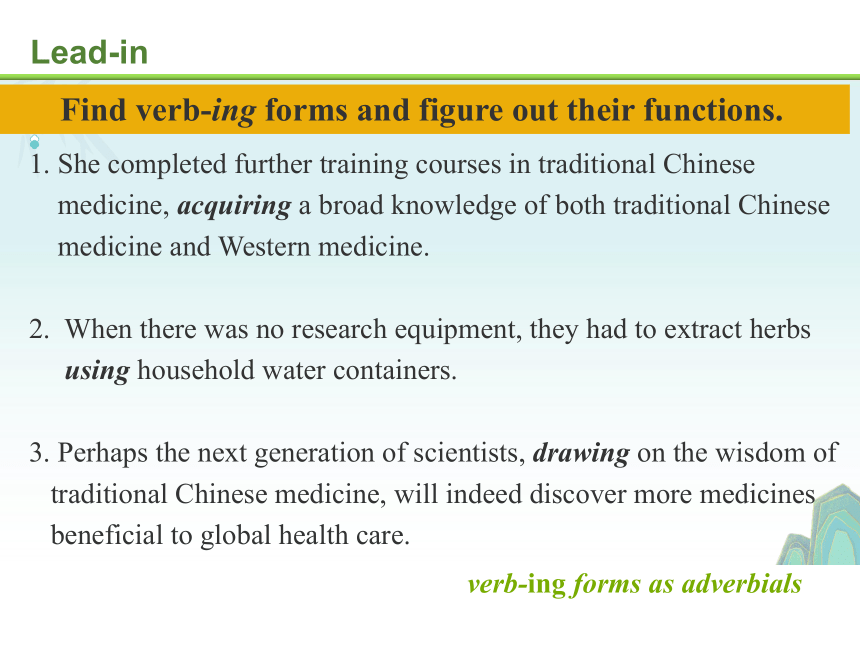
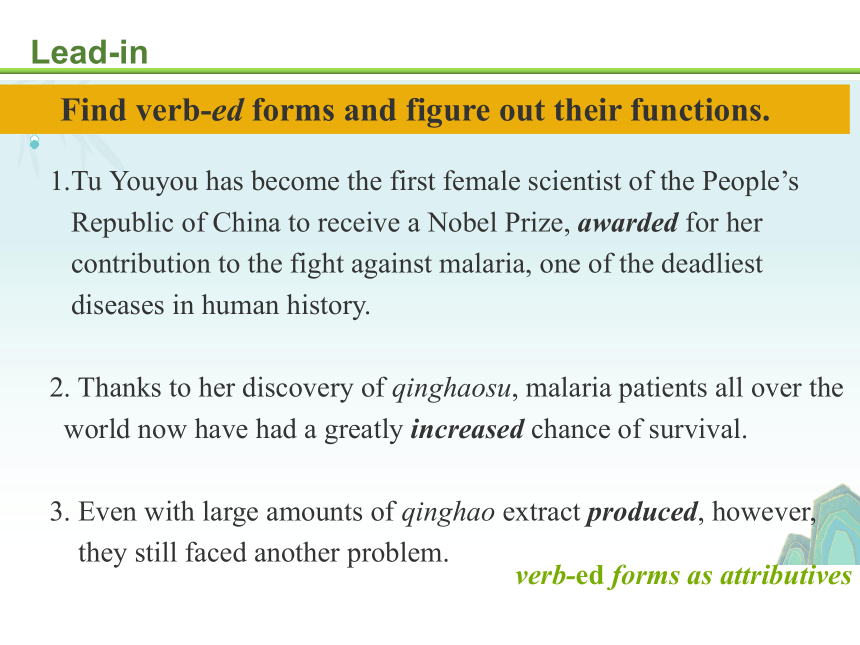
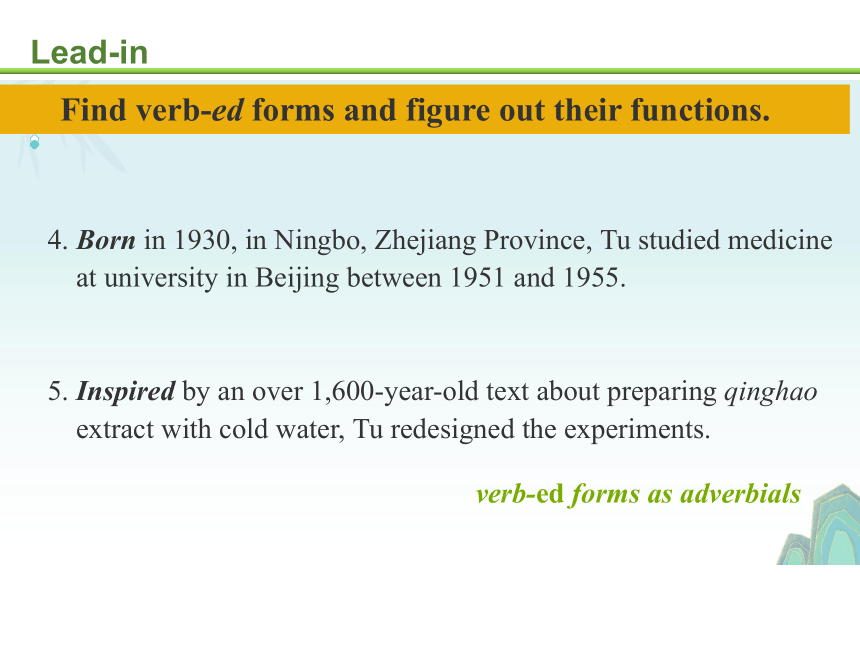
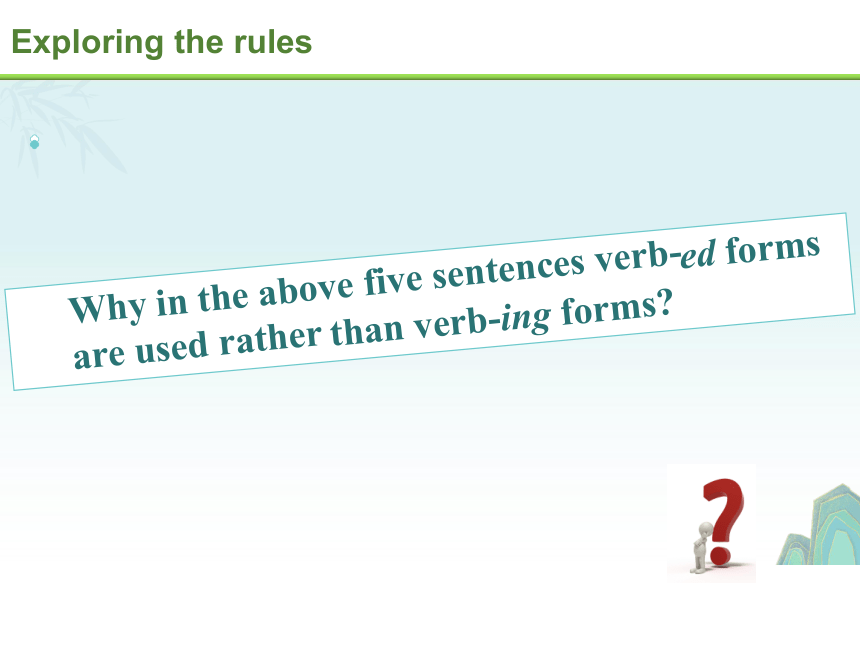
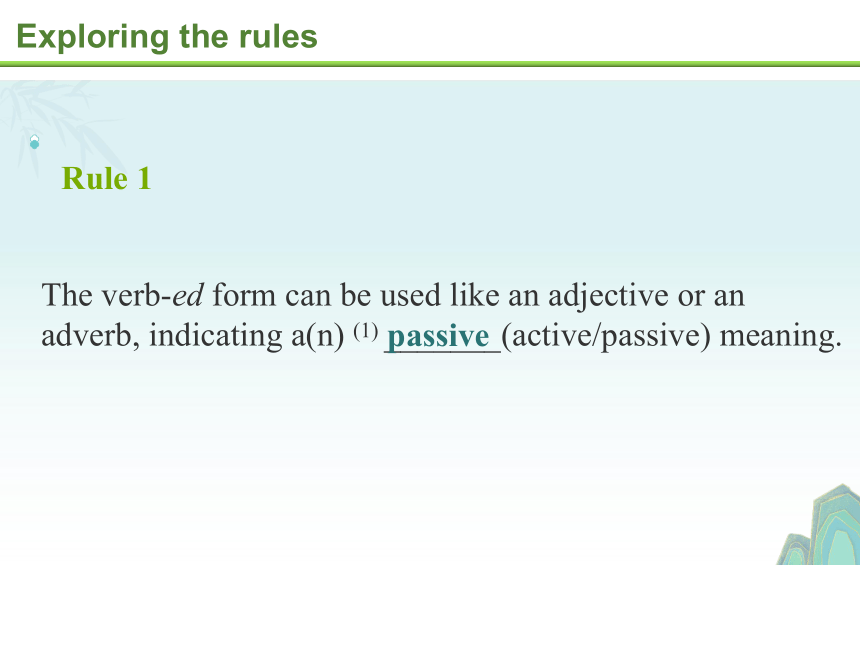
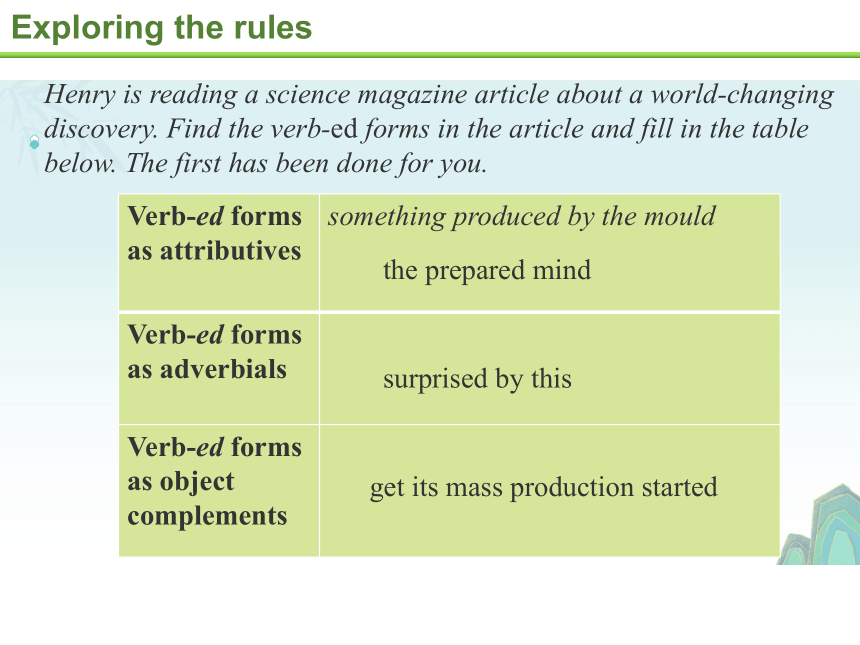
文档简介
(共25张PPT)
Unit 4 Scientists who changed the world
Grammar and usage
Verb-ed forms as attributives,
adverbials and object complements
Grammar and usage
1. Tu Youyou has become the first female scientist of the People’s
Republic of China to receive a Nobel Prize, awarded for her
contribution to the fight against malaria, one of the deadliest
diseases in human history.
2. To speed up the process and ensure its safety, Tu and her team
volunteered to test qinghao extract on themselves first.
to-infinitive as attributive
to-infinitive as adverbial of purpose
Find to-infinitives and figure out their functions.
Lead-in
1. She completed further training courses in traditional Chinese
medicine, acquiring a broad knowledge of both traditional Chinese
medicine and Western medicine.
2. When there was no research equipment, they had to extract herbs
using household water containers.
3. Perhaps the next generation of scientists, drawing on the wisdom of
traditional Chinese medicine, will indeed discover more medicines
beneficial to global health care.
verb-ing forms as adverbials
Lead-in
Find verb-ing forms and figure out their functions.
1.Tu Youyou has become the first female scientist of the People’s
Republic of China to receive a Nobel Prize, awarded for her
contribution to the fight against malaria, one of the deadliest
diseases in human history.
2. Thanks to her discovery of qinghaosu, malaria patients all over the
world now have had a greatly increased chance of survival.
3. Even with large amounts of qinghao extract produced, however,
they still faced another problem.
verb-ed forms as attributives
Lead-in
Find verb-ed forms and figure out their functions.
4. Born in 1930, in Ningbo, Zhejiang Province, Tu studied medicine
at university in Beijing between 1951 and 1955.
5. Inspired by an over 1,600-year-old text about preparing qinghao
extract with cold water, Tu redesigned the experiments.
verb-ed forms as adverbials
Lead-in
Find verb-ed forms and figure out their functions.
Why in the above five sentences verb-ed forms
are used rather than verb-ing forms
Exploring the rules
The verb-ed form can be used like an adjective or an
adverb, indicating a(n) (1) _______(active/passive) meaning.
passive
Rule 1
Exploring the rules
Verb-ed forms as attributives something produced by the mould
Verb-ed forms as adverbials
Verb-ed forms as object complements
the prepared mind
surprised by this
get its mass production started
Exploring the rules
Henry is reading a science magazine article about a world-changing
discovery. Find the verb-ed forms in the article and fill in the table
below. The first has been done for you.
The verb-ed form can appear before or after a noun or pronoun. It modifies the noun or pronoun like a(n) (2)_____________ (relative clause/adverbial clause).
relative clause
Rule 2
Rule 3
The verb-ed form can be used as an adverbial or an object
complement.
Exploring the rules
Verb-ed forms as attributives
观察下列句子中动词-ed形式作定语的位置
· The results indicated that something produced by the mould had
killed the bacteria.
· Fortune favours the prepared mind.
单个动词-ed形式作定语,常被置于被修饰词之前;
动词-ed形式短语作定语,常被置于被修饰词之后。
注意1:
总结1:
动词-ed形式通常表示被动含义, 但不及物动词的-ed形式除外。
a respected writer
=a writer who is respected
trained employees
=employees who have been
trained before
the sunken ship
=the ship that has sunken
fallen leaves
=leaves that have fallen
比
较
及物动词的动词-ed形式作定语,通常即表示已经完成,又可以表示被动的意义。
不及物动词的-ed形式作定语,常表示已发生的动作。
总结:
注意2:
Verb-ed forms as attributives
1. Most of the people (invite) to the party are famous scientists.
2. The EMS (post) yesterday will reach my brother in three
days.
3. There has been nothing (change) here since I left this city.
4. She is a (respect) teacher.
invited
posted
changed
Practice
respected
Verb-ed forms as adverbials
注意1:
观察下列句子中的动词-ed形式表达的意义
· Seen from the top of the mountain, the river looks like a dragon.
· Greatly interested, I began to read the book.
· The professor entered the hall, followed by a group of students.
动词-ed形式作状语,常表示时间、原因、伴随情
况等。
总结1:
特别提醒:
Given more time, he could finish the task. ( √ )
Given more time, I think he could finish the task. (×)
动词-ed形式作状语,其逻辑主语与句子主语一致。
Rewrite the following sentences, verb-ed forms as adverbials.
Practice
1. He was buried in an ocean of loneliness and felt left out.
Buried in an ocean of loneliness, he felt left out.
2. As she was given advice by the famous detective, the girl was no longer afraid.
Given advice by the famous detective, the girl was no longer afraid.
3. Even if he was laughed at by many people, he continued his research.
Laughed at by many people, he continued his research.
Verb-ed forms as object complements
注意1:观察什么动词后常接动词-ed形式作宾语补足语?
1. I heard him criticized many times.
2. You will see this product advertised wherever you go.
3. They will have you arrested if you don't pay your taxes.
总结1:
动词-ed形式可在see, hear, notice, feel, have, make,
keep, leave等动词后作宾语补足语。
Fill in the blanks, using the correct verb forms.
1. I watched him _____ (step) off the pavement and _________
(disappear) into the post office.
2. The hall was too noisy for the speaker to make himself _____ (hear).
3. We found all the rivers seriously __________ (pollute).
4. Alice got her bad tooth __________ (pull out) in the hospital.
step
polluted
disappear
pulled out
Practice
heard
1. The scientist who has been highly praised won an award.
2. The experiment that is mentioned in your article is interesting.
3. The patients soon recovered because they were treated with the new
medicine.
Rewrite the following sentences using verb-ed forms as
attributives, adverbials or object complements.
B1
The highly praised scientist won an award.
The experiment mentioned in your article is interesting.
Treated with the new medicine, the patients soon recovered.
Applying the rules
4. The scientist found that the equipment in the laboratory had been
destroyed.
5. Once this report is finished, it will be very useful for future research.
Rewrite the following sentences using verb-ed forms as
attributives, adverbials or object complements.
B1
The scientist found the equipment in the laboratory destroyed.
Once finished, this report will be very useful for future research.
Applying the rules
Benjamin Franklin was a famous scientist, writer, printer, inventor and politician.
As a scientist, he was well known for his kite experiment. The story goes like this:
Franklin had found lightning (1) _________ (interest) for years, believing it was
actually electricity. He designed an experiment to prove his theory.
He worked out that by flying a kite during a thunderstorm, electricity could go
through the wet kite line down to the earth. (2) _________ (know) it was too dangerous
to hold the wet line, Franklin held a silk ribbon (3) ____(tie) to the end of it.
He made sure the silk ribbon stayed dry so that the electricity would not go through
his body. Then he attached a metal key where the ribbon and kite line joined. When
a thunderstorm approached, the lightning would charge the key. (4) _________
(conduct) on a stormy day in 1752, his experiment proved lightning was really just
electricity.
Franklin had his theory (5) _________ (accept) by many people. However, some
people questioned whether he had actually done the experiment, (6) _________ (argue)
that if he had really done it, he would have received a deadly electric shock.
Whatever the truth, Franklin did make contributions to the studies of electricity.
B2
Henry is reading an article about Franklin's kite plete the
article below with the correct verb-ed forms or verb-ing forms.
interesting
Knowing
tied
Conducted
accepted
arguing
Looked at a world map and found the eastern coastline of South America and
the western coastline of Africa could fit together;
Did more research and put forward the theory of continental drift;
Published his ideas in The Origin of Continents and Oceans;
People did not accept his theory partly because:
it challenged many theories at that time;
Wegener could not explain the driving force behind continental drift.
Looking at a world map, Alfred Wegener found ...
B3
Read the notes below about Alfred Wegener and his theory of continental drift. Then write a short paragraph using verb-ed forms, verb-ing forms and to-infinitives. The beginning has been written for you.
Looking at a world map, Alfred Wegener found something amazing: the eastern coastline of South America and the western coastline of Africa seemed to fit together. He did more research to find out what caused this. Having collected enough evidence, he put forward his theory of continental drift. Then he had his ideas published in The Origin of Continents and Oceans. However, people did not believe in his theory. For one thing, it challenged many scientific theories widely accepted at that time. For another, Wegener failed to explain the driving force causing the continents to drift apart.
Sample
Finish Part C on page 76.
homework
_____________________________________________________________
感谢观看
Unit 4 Scientists who changed the world
Grammar and usage
Verb-ed forms as attributives,
adverbials and object complements
Grammar and usage
1. Tu Youyou has become the first female scientist of the People’s
Republic of China to receive a Nobel Prize, awarded for her
contribution to the fight against malaria, one of the deadliest
diseases in human history.
2. To speed up the process and ensure its safety, Tu and her team
volunteered to test qinghao extract on themselves first.
to-infinitive as attributive
to-infinitive as adverbial of purpose
Find to-infinitives and figure out their functions.
Lead-in
1. She completed further training courses in traditional Chinese
medicine, acquiring a broad knowledge of both traditional Chinese
medicine and Western medicine.
2. When there was no research equipment, they had to extract herbs
using household water containers.
3. Perhaps the next generation of scientists, drawing on the wisdom of
traditional Chinese medicine, will indeed discover more medicines
beneficial to global health care.
verb-ing forms as adverbials
Lead-in
Find verb-ing forms and figure out their functions.
1.Tu Youyou has become the first female scientist of the People’s
Republic of China to receive a Nobel Prize, awarded for her
contribution to the fight against malaria, one of the deadliest
diseases in human history.
2. Thanks to her discovery of qinghaosu, malaria patients all over the
world now have had a greatly increased chance of survival.
3. Even with large amounts of qinghao extract produced, however,
they still faced another problem.
verb-ed forms as attributives
Lead-in
Find verb-ed forms and figure out their functions.
4. Born in 1930, in Ningbo, Zhejiang Province, Tu studied medicine
at university in Beijing between 1951 and 1955.
5. Inspired by an over 1,600-year-old text about preparing qinghao
extract with cold water, Tu redesigned the experiments.
verb-ed forms as adverbials
Lead-in
Find verb-ed forms and figure out their functions.
Why in the above five sentences verb-ed forms
are used rather than verb-ing forms
Exploring the rules
The verb-ed form can be used like an adjective or an
adverb, indicating a(n) (1) _______(active/passive) meaning.
passive
Rule 1
Exploring the rules
Verb-ed forms as attributives something produced by the mould
Verb-ed forms as adverbials
Verb-ed forms as object complements
the prepared mind
surprised by this
get its mass production started
Exploring the rules
Henry is reading a science magazine article about a world-changing
discovery. Find the verb-ed forms in the article and fill in the table
below. The first has been done for you.
The verb-ed form can appear before or after a noun or pronoun. It modifies the noun or pronoun like a(n) (2)_____________ (relative clause/adverbial clause).
relative clause
Rule 2
Rule 3
The verb-ed form can be used as an adverbial or an object
complement.
Exploring the rules
Verb-ed forms as attributives
观察下列句子中动词-ed形式作定语的位置
· The results indicated that something produced by the mould had
killed the bacteria.
· Fortune favours the prepared mind.
单个动词-ed形式作定语,常被置于被修饰词之前;
动词-ed形式短语作定语,常被置于被修饰词之后。
注意1:
总结1:
动词-ed形式通常表示被动含义, 但不及物动词的-ed形式除外。
a respected writer
=a writer who is respected
trained employees
=employees who have been
trained before
the sunken ship
=the ship that has sunken
fallen leaves
=leaves that have fallen
比
较
及物动词的动词-ed形式作定语,通常即表示已经完成,又可以表示被动的意义。
不及物动词的-ed形式作定语,常表示已发生的动作。
总结:
注意2:
Verb-ed forms as attributives
1. Most of the people (invite) to the party are famous scientists.
2. The EMS (post) yesterday will reach my brother in three
days.
3. There has been nothing (change) here since I left this city.
4. She is a (respect) teacher.
invited
posted
changed
Practice
respected
Verb-ed forms as adverbials
注意1:
观察下列句子中的动词-ed形式表达的意义
· Seen from the top of the mountain, the river looks like a dragon.
· Greatly interested, I began to read the book.
· The professor entered the hall, followed by a group of students.
动词-ed形式作状语,常表示时间、原因、伴随情
况等。
总结1:
特别提醒:
Given more time, he could finish the task. ( √ )
Given more time, I think he could finish the task. (×)
动词-ed形式作状语,其逻辑主语与句子主语一致。
Rewrite the following sentences, verb-ed forms as adverbials.
Practice
1. He was buried in an ocean of loneliness and felt left out.
Buried in an ocean of loneliness, he felt left out.
2. As she was given advice by the famous detective, the girl was no longer afraid.
Given advice by the famous detective, the girl was no longer afraid.
3. Even if he was laughed at by many people, he continued his research.
Laughed at by many people, he continued his research.
Verb-ed forms as object complements
注意1:观察什么动词后常接动词-ed形式作宾语补足语?
1. I heard him criticized many times.
2. You will see this product advertised wherever you go.
3. They will have you arrested if you don't pay your taxes.
总结1:
动词-ed形式可在see, hear, notice, feel, have, make,
keep, leave等动词后作宾语补足语。
Fill in the blanks, using the correct verb forms.
1. I watched him _____ (step) off the pavement and _________
(disappear) into the post office.
2. The hall was too noisy for the speaker to make himself _____ (hear).
3. We found all the rivers seriously __________ (pollute).
4. Alice got her bad tooth __________ (pull out) in the hospital.
step
polluted
disappear
pulled out
Practice
heard
1. The scientist who has been highly praised won an award.
2. The experiment that is mentioned in your article is interesting.
3. The patients soon recovered because they were treated with the new
medicine.
Rewrite the following sentences using verb-ed forms as
attributives, adverbials or object complements.
B1
The highly praised scientist won an award.
The experiment mentioned in your article is interesting.
Treated with the new medicine, the patients soon recovered.
Applying the rules
4. The scientist found that the equipment in the laboratory had been
destroyed.
5. Once this report is finished, it will be very useful for future research.
Rewrite the following sentences using verb-ed forms as
attributives, adverbials or object complements.
B1
The scientist found the equipment in the laboratory destroyed.
Once finished, this report will be very useful for future research.
Applying the rules
Benjamin Franklin was a famous scientist, writer, printer, inventor and politician.
As a scientist, he was well known for his kite experiment. The story goes like this:
Franklin had found lightning (1) _________ (interest) for years, believing it was
actually electricity. He designed an experiment to prove his theory.
He worked out that by flying a kite during a thunderstorm, electricity could go
through the wet kite line down to the earth. (2) _________ (know) it was too dangerous
to hold the wet line, Franklin held a silk ribbon (3) ____(tie) to the end of it.
He made sure the silk ribbon stayed dry so that the electricity would not go through
his body. Then he attached a metal key where the ribbon and kite line joined. When
a thunderstorm approached, the lightning would charge the key. (4) _________
(conduct) on a stormy day in 1752, his experiment proved lightning was really just
electricity.
Franklin had his theory (5) _________ (accept) by many people. However, some
people questioned whether he had actually done the experiment, (6) _________ (argue)
that if he had really done it, he would have received a deadly electric shock.
Whatever the truth, Franklin did make contributions to the studies of electricity.
B2
Henry is reading an article about Franklin's kite plete the
article below with the correct verb-ed forms or verb-ing forms.
interesting
Knowing
tied
Conducted
accepted
arguing
Looked at a world map and found the eastern coastline of South America and
the western coastline of Africa could fit together;
Did more research and put forward the theory of continental drift;
Published his ideas in The Origin of Continents and Oceans;
People did not accept his theory partly because:
it challenged many theories at that time;
Wegener could not explain the driving force behind continental drift.
Looking at a world map, Alfred Wegener found ...
B3
Read the notes below about Alfred Wegener and his theory of continental drift. Then write a short paragraph using verb-ed forms, verb-ing forms and to-infinitives. The beginning has been written for you.
Looking at a world map, Alfred Wegener found something amazing: the eastern coastline of South America and the western coastline of Africa seemed to fit together. He did more research to find out what caused this. Having collected enough evidence, he put forward his theory of continental drift. Then he had his ideas published in The Origin of Continents and Oceans. However, people did not believe in his theory. For one thing, it challenged many scientific theories widely accepted at that time. For another, Wegener failed to explain the driving force causing the continents to drift apart.
Sample
Finish Part C on page 76.
homework
_____________________________________________________________
感谢观看
同课章节目录
- Unit 1 Nature in the balance
- Welcome to the unit
- Reading
- Grammar and usage
- Integrated skills
- Extended reading
- Project
- Unit 2 Natural disasters
- Welcome to the unit
- Reading
- Grammar and usage
- Integrated skills
- Extended reading
- Project
- Unit 3 The world online
- Welcome to the unit
- Reading
- Grammar and usage
- Integrated skills
- Extended reading
- Project
- Unit 4 Scientists who changed the world
- Welcome to the unit
- Reading
- Grammar and usage
- Integrated skills
- Extended reading
- Project
